<< Previous | Displaying results 4526-4550 of 6769 for "" | Next >>
[This video is silent] The film "The Nazi Plan" was shown as evidence at the International Military Tribunal in Nuremberg on December 11, 1945. It was compiled for the trial by Budd Schulberg and other US military personnel, under the supervision of Navy Commander James Donovan. The compilers used only German source material, including official newsreels. This footage is titled "Opening of the Official Anti-Semitic Campaign 1 April 1933."
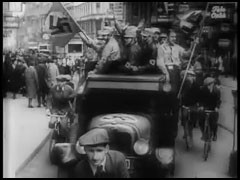
The film "The Nazi Plan" was shown as evidence at the International Military Tribunal in Nuremberg on December 11, 1945. It was compiled for the trial by Budd Schulberg and other US military personnel, under the supervision of Navy Commander James Donovan. The compilers used only German source material, including official newsreels. This footage is titled "The Burning of the Books, 10 May 1933."

The film "The Nazi Plan" was shown as evidence at the International Military Tribunal in Nuremberg on December 11, 1945. It was compiled for the trial by Budd Schulberg and other US military personnel, under the supervision of Navy Commander James Donovan. The compilers used only German source material, including official newsreels. In this footage titled "Seventh Party Congress 10–16 September 1935," Hermann Göring announces restrictive racial laws.
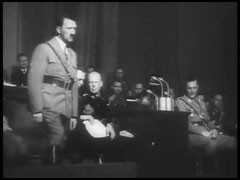
The film "The Nazi Plan" was shown as evidence at the International Military Tribunal in Nuremberg on December 11, 1945. It was compiled for the trial by Budd Schulberg and other US military personnel, under the supervision of Navy Commander James Donovan. The compilers used only German source material, including official newsreels. This footage titled "Hitler Predicts Annihilation of the Jewish Race in Europe if War Occurs" shows Hitler delivering a speech to the German parliament on January 30, 1939.
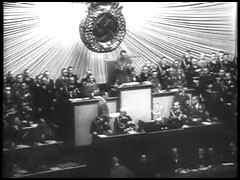
The film "The Nazi Plan" was shown as evidence at the International Military Tribunal in Nuremberg on December 11, 1945. It was compiled for the trial by Budd Schulberg and other US military personnel, under the supervision of Navy Commander James Donovan. The compilers used only German source material, including official newsreels. This footage titled "Conferences After Hitler's Escape from Bombing Plot, 20 July 1944" was used by Nuremberg prosecutors to show that the IMT defendants were among Hitler's…
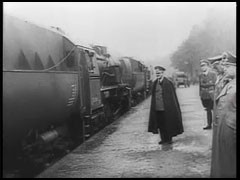
This footage comes from "Nuremberg, Its Lesson for Today" a 1947 documentary film produced by the US military's Documentary Film Unit, Information Services Division. The film, directed by Pare Lorentz and Stuart Schulberg, shows footage from the trial of Nazi war criminals by the International Military Tribunal. It also intermixes historical footage depicting the founding of the Nazi state, the unleashing of World War II, and Nazi crimes against humanity. The sentencing sequence shown here illustrates the…

In the Justice Case of the Subsequent Nuremberg Proceedings, nine officials from the German Ministry of Justice and seven members of the Nazi-era People's and Special Courts were charged with “judicial murder and other atrocities, which they committed by destroying law and justice in Germany, and then utilizing the emptied forms of legal process for the persecution, enslavement and extermination on a large scale.” This footage shows US prosecutor Telford Taylor describing the defendants.
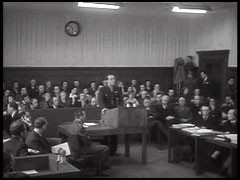
In the Justice Case of the Subsequent Nuremberg Proceedings, nine officials from the German Ministry of Justice and seven members of the Nazi-era People's and Special Courts were charged with “judicial murder and other atrocities, which they committed by destroying law and justice in Germany, and then utilizing the emptied forms of legal process for the persecution, enslavement and extermination on a large scale.” In this footage from the trial, US prosecutor Telford Taylor describes the nature…
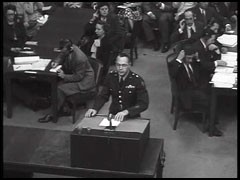
At the end of World War II, more than three-quarters of the city of Nuremberg, Germany, lay in rubble. This US Army Air Corps color footage shows some of the war damage in Nuremberg, which had been host in the 1920s and 1930s to massive and lavish rallies for the Nazi party.
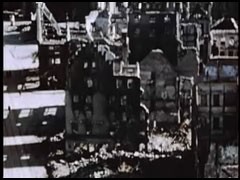
In the 1920s and 1930s, the German city of Nuremberg was host to massive and lavish rallies for the Nazi Party. This film footage, produced by Julien Bryan in 1937, shows saluting crowds in the Nuremberg stadium watching groups parade past Adolf Hitler.
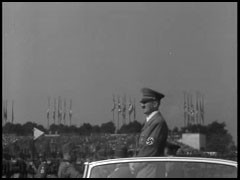
Lieutenant Colonel Baldwin of the US prosecution team presents the case against defendant Hans Frank at the Nuremberg trial. Baldwin refers to several of Frank's diary entries about the appropriation of scarce Polish grain for use as food in Germany.
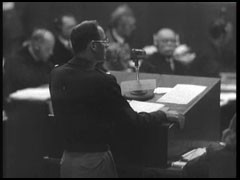
Defendant Hans Frank gives testimony to his defense lawyer during the Nuremberg trial about his leadership roles during the Third Reich.
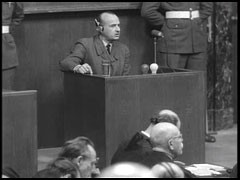
US prosecutor Thomas Dodd cross examines defandant Walter Funk, former president of the German national bank. Dodd questions Funk about the possessions confiscated from concentration camp prisoners and elsewhere in German-occupied territories.
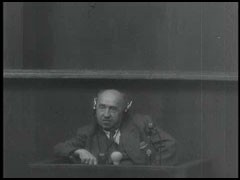
Defendant Hermann Göring, seated at left in the dock, listens as US Chief Prosecutor Robert Jackson interrogates witness Albert Kesselring about the Luftwaffe (German Air Force).
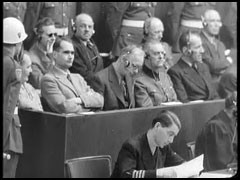
Hitler congratulates industrialist Gustav Krupp after presenting him with a Nazi party honor. After the ceremony, they toured a Krupp factory. This footage comes from the film "The Nazi Plan," produced and used by the United States in the prosecution at the Nuremberg trials.
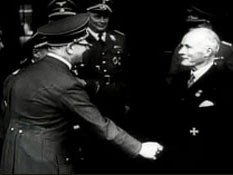
Francois Boix, a concentration camp survivor, testifies about Albert Speer's visit to the Mauthausen concentration camp. Boix identifies Speer by pointing to him in the defendants' dock.
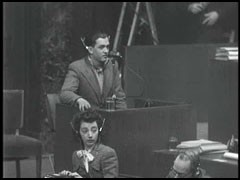
Defendant Albert Speer is sworn in at the International Military Tribunal.
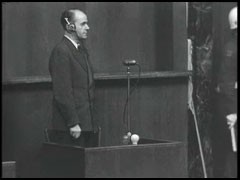
Albert Speer gives testimony at the International Military Tribunal. In 1942 Speer was named Minister of Armaments and Munitions, assuming significant responsibility for the German war economy. In this position, Speer used millions of forced laborers to raise economic production.
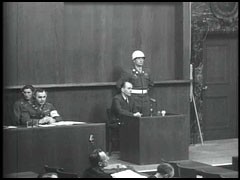
Defendant Albert Speer making his closing statement in the Nuremberg courtroom.
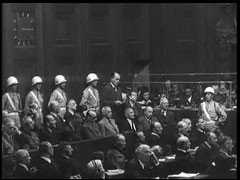
Defendant Julius Streicher is sworn in as a witness during the International Military Tribunal at Nuremberg.

This film clip shows translators in action at the Nuremberg trial. English, French, Russian, and German were the official languages of the Nuremberg trials. Interpreters provided simultaneous translations of the court proceedings which were then available to the trial participants via headphones.
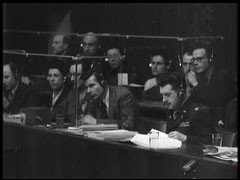
This film clip shows the use of headphones at the International Military Tribunal. English, French, Russian, and German were the official languages of the Nuremberg trials. Translators provided simultaneous translations of the proceedings. Each participant in the trial had a set of headphones.
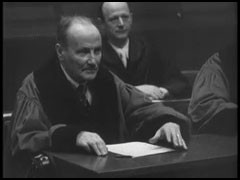
US prosecutor Thomas Dodd introduces the film compilation "Nazi Concentration Camps." At the end of the courtroom scene shown here, the lights are dimmed for the screening. The footage, filmed as Allied troops liberated the concentration camps, was presented in the courtroom on November 29, 1945, and entered as evidence in the trial.
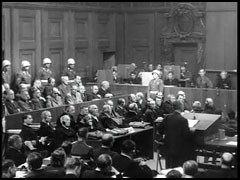
Clip from George Stevens' "The Nazi Concentration Camps." This German film footage was compiled as evidence and used by the prosecution at the Nuremberg trials.
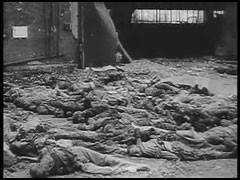
Clip from George Stevens' "The Nazi Concentration Camps." This German film footage was compiled as evidence and used by the prosecution at the Nuremberg trials.
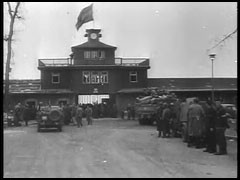
We would like to thank Crown Family Philanthropies, Abe and Ida Cooper Foundation, the Claims Conference, EVZ, and BMF for supporting the ongoing work to create content and resources for the Holocaust Encyclopedia. View the list of donor acknowledgement.